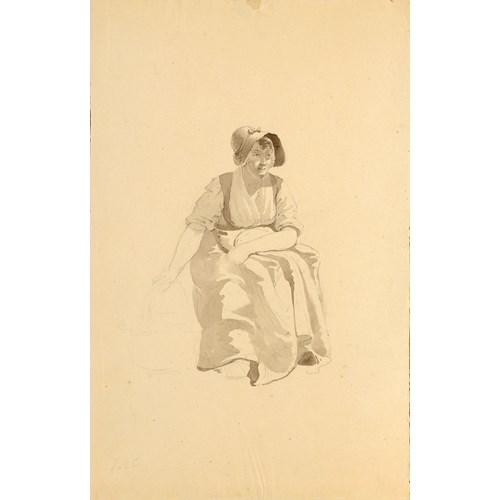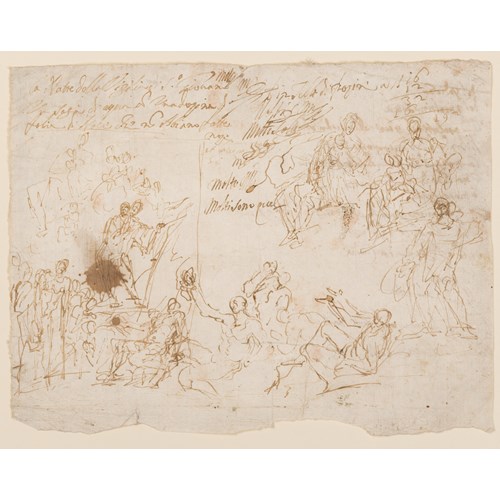Giovanni Battista Tiepolo
Allegorical Figures of Valour and Fame: The Apotheosis of a Warrior
Date Late 1740s or 1750s
Epoque 1600-1750, 1750-1850, 18th century
Origine Italy, Spain
Medium Pen, Brown ink, Brown wash, Black chalk
Dimension 21.6 x 28.9 cm (8¹/₂ x 11³/₈ inches)
The late Tiepolo scholar George Knox related several of these drawings to Tiepolo’s ceiling fresco of an Allegory of Merit Between Nobility and Virtue in one of the rooms of the Ca’ Rezzonico in Venice, painted in the spring of 1757 to celebrate the forthcoming marriage of Ludovico Rezzonico and Faustina Savorgnan, and one of the last major decorative works completed by the artist in Italy before his move to Spain in 1762. As James Byam Shaw has noted of Tiepolo’s drawings of this type, however, ‘there is seldom an exact correspondence with the finished work, so that sometimes it is difficult to decide whether the drawing is a preliminary idea, or a return to an earlier motive.’ As such, some of these drawings may perhaps also be related to a number of other ceiling paintings of analogous subjects. Indeed, as Knox has pointed out, ‘The theme of the apotheosis of the hero recurs often in the Tiepolo oeuvre, both in his painting and in his drawings’, a statement echoed by another recent scholar, who writes that ‘[A] type of figure, where a member of a patrician family is shown with the attributes of Valor, would prove to be one of Tiepolo’s most durable creations.’
A similar laurel-wreathed soldier accompanied by a trumpet-bearing figure of Fame, for example, appears in Tiepolo’s ceiling canvas of The Glorification of the Barbaro Family (or Valour with Virtue and Fame and Other Virtues) of c.1750, painted for the Palazzo Barbaro in Venice and now in the Metropolitan Museum of Art in New York. Other ceiling paintings of similar subjects executed in the 1750s include a vast Apotheosis of Francesco Morosini (or Fame with Valour and Virtue), painted for the Palazzo Morosini a Santo Stefano in Venice and now in the Palazzo Isimbardi in Milan, and a fresco of The Apotheosis of Orazio Porto (or Valour Crowned by Virtue Overcoming Time), painted for the Palazzo Porto in Vicenza and now in the Seattle Art Museum.
As a draughtsman, Giambattista Tiepolo favoured pen, ink and brush, and the present sheet is a superb example of his abilities. As James Byam Shaw has described the artist’s technique, ‘Often he used a hard black chalk, or a lead point, to indicate first, very roughly, the main character of the composition; then comes the finely cut quill – more rarely a reed – to sketch the forms; and finally a brush, with a tawny bistre or greyish-brown colour, for the shadows. This wash is often the lightest possible, and of a single tone, or varying only according to the fullness of the brush; but often, and especially in more pictorial compositions, there are two distinct tones...strong accents being added with a drier brush, over the lighter and more transparent wash, before this was completely dry...there is a remarkable degree of volume and solidity, which, with his delicate line and apparently casual washes, the artist is able to impart to all his forms.’
The first known owner of the present sheet was the eminent biologist William Bateson, FRS (1861-1926), who owned a choice group of pen and ink drawings by Giambattista Tiepolo. In 1911 Bateson lent this drawing, along with several others by the artist, to the seminal Exhibition of Venetian Painting of the Eighteenth Century at the Burlington Fine Arts Club in London. This drawing, however, does not seem to have been included in the posthumous sale of Bateson’s collection of drawings, held at Sotheby’s in London on 23-24 April 1929, which included twenty-six drawings by Tiepolo.
According to a label on the old backing board, the present sheet later entered the collection of the French art historian Adrien Fauchier-Magnan (1873-1965).
Date: Late 1740s or 1750s
Epoque: 1600-1750, 1750-1850, 18th century
Origine: Italy, Spain
Medium: Pen, Brown ink, Brown wash, Black chalk
Signature: Inscribed M. Fauchier Magnan / J. B. Tiepolo / Allegorie on a label pasted onto the old backing board.
Dimension: 21.6 x 28.9 cm (8¹/₂ x 11³/₈ inches)
Provenance: William Bateson, Merton House, Grantchester, nr. Cambridge, in 1910
Adrien Fauchier-Magnan, Neuilly-sur-Seine (according to a label on the old backing board)
Winterfeld collection
Anonymous sale (‘The Property of a Gentleman’), London, Sotheby’s, 9 December 1936, lot 59 (as ‘The Genii of Victory and Fame’), bt. Walford Wilson for £90
E. V. Thaw and Co., New York
John R. Gaines, Lexington, Kentucky
His sale, New York, Sotheby’s, 17 November 1986, lot 23
Private collection.
Literature: Eduard Sack, Giambattista und Domenico Tiepolo: Ihr Leben und ihre Werk, Hamburg, 1910, p.252, no.103 (not illustrated).
Exhibition: London, Burlington Fine Arts Club, Exhibition of Venetian Painting of the Eighteenth Century, 1911, no.65 (as The Genii of Victory and Fame, lent by Bateson).
Plus d'œuvres d'art de la Galerie






_T638203653401123575.jpg?width=500&height=500&mode=pad&scale=both&qlt=90&format=jpg)
 with a Letter_T638636408485097530.jpg?width=500&height=500&mode=pad&scale=both&qlt=90&format=jpg)

